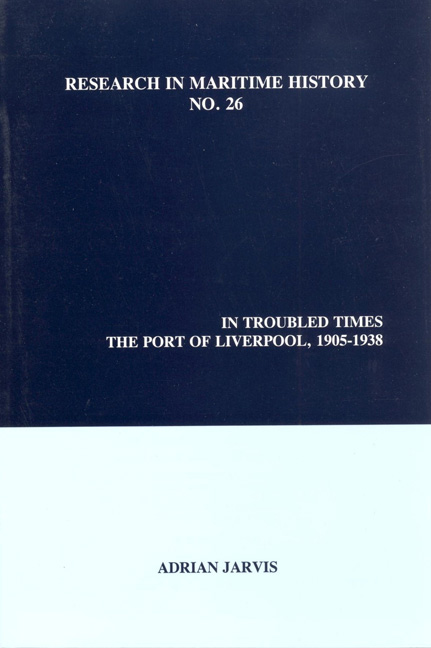Book contents
- Frontmatter
- Table of Contents
- List of Figures
- Foreword and Acknowledgements
- Conversion Factors for Imperial Measurements
- Introduction: The Port of Liverpool in 1905
- Chapter 1 The Port and Its Trade in 1905
- Chapter 2 Gladstone Dock
- Chapter 3 Not Before Time: The Board Keeps its Promise
- Chapter 4 Engineering, Management and Decision-making
- Chapter 5 Making the Customers Happy
- Chapter 6 Sand, Silt and Sewage: The Work of the Board's Dredgers
- Chapter 7 The Provision of Specialist Cargo Facilities
- Chapter 8 Into the Modern World?
- Conclusion: On the Eve of War
- Appendix: Port Efficiency: A Short Methodological Discourse
- A Note on Sources: Abbreviations
- Bibliography
- Index
Chapter 2 - Gladstone Dock
- Frontmatter
- Table of Contents
- List of Figures
- Foreword and Acknowledgements
- Conversion Factors for Imperial Measurements
- Introduction: The Port of Liverpool in 1905
- Chapter 1 The Port and Its Trade in 1905
- Chapter 2 Gladstone Dock
- Chapter 3 Not Before Time: The Board Keeps its Promise
- Chapter 4 Engineering, Management and Decision-making
- Chapter 5 Making the Customers Happy
- Chapter 6 Sand, Silt and Sewage: The Work of the Board's Dredgers
- Chapter 7 The Provision of Specialist Cargo Facilities
- Chapter 8 Into the Modern World?
- Conclusion: On the Eve of War
- Appendix: Port Efficiency: A Short Methodological Discourse
- A Note on Sources: Abbreviations
- Bibliography
- Index
Summary
On New Year's Day 1902 the Docks and Quays Committee of the MD&HB addressed a request to the Works Committee that it consider preliminary steps for utilising the land to the north of Hornby Dock to provide accommodation for vessels of up to 1000 feet in length. Reference back to chapter one will reveal that this was a very large size to be discussing before Lusitania and Mauretania were even contemplated, much less designed. The largest ship in the world at the time was the White Star Line's Celtic (1901), of 20,904 gross register tons (grt) and 681 feet in length. Two days later, the Works Committee instructed A.G. Lyster, the Engineer-in-Chief, to show how this land could best be utilised for “vessels of the largest conceivable dimensions.” The change in wording is interesting, for when the Board first approved the drawings for the entrance lock it was only 870-feet long: its lengthening to 1070 feet came much later and after many changes of plan, of which more below. This could be taken to indicate that from the start the idea of a ship of 1000 feet was to some members larger than “the largest conceivable dimensions.” That must remain in the realms of speculation, however, because the Works Committee Support Papers which would confirm or deny it do not survive for that year. It was, however, normal for committee clerks to recite back inter-committee requests verbatim when they came to write up the minutes. At the Works Committee meeting of 7 February Lyster came back with some preliminary sketches which made it clear that for a facility of the size envisaged the land the Board already owned was insufficient, and the Solicitor was instructed to “take preliminary steps” to acquire some fiftythree acres that Lyster had identified as necessary.
The need for Gladstone was obvious to the members of the Board, but they kept their intentions to themselves for two very sound reasons. Since the announcement of the scheme would cause a rapid rise in the value of land in the vicinity, as such announcements always did, secrecy must be maintained as far as possible until the Board acquired all the land it needed, and minor purchases continued into 1905 when, as mentioned above, some small-scale preliminary work and some large-scale site clearance had already begun.
- Type
- Chapter
- Information
- In Troubled TimesThe Port of Liverpool, 1905-1938, pp. 43 - 70Publisher: Liverpool University PressPrint publication year: 2003



